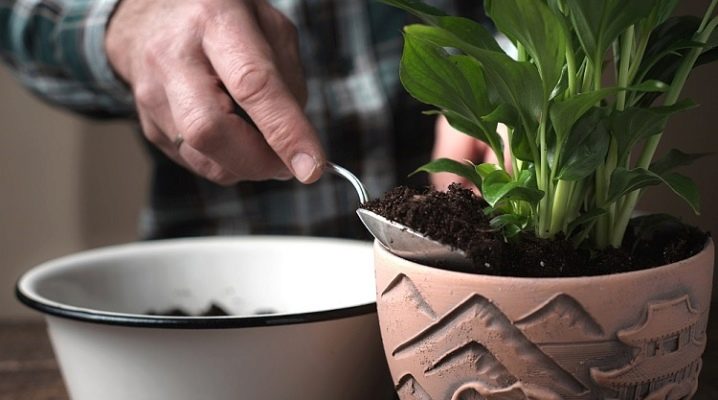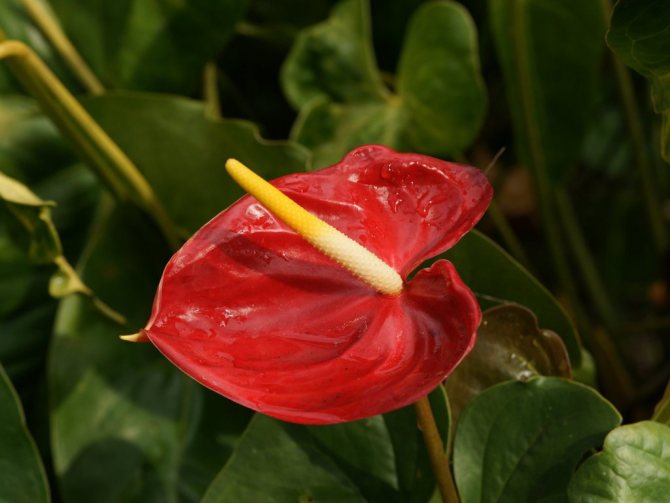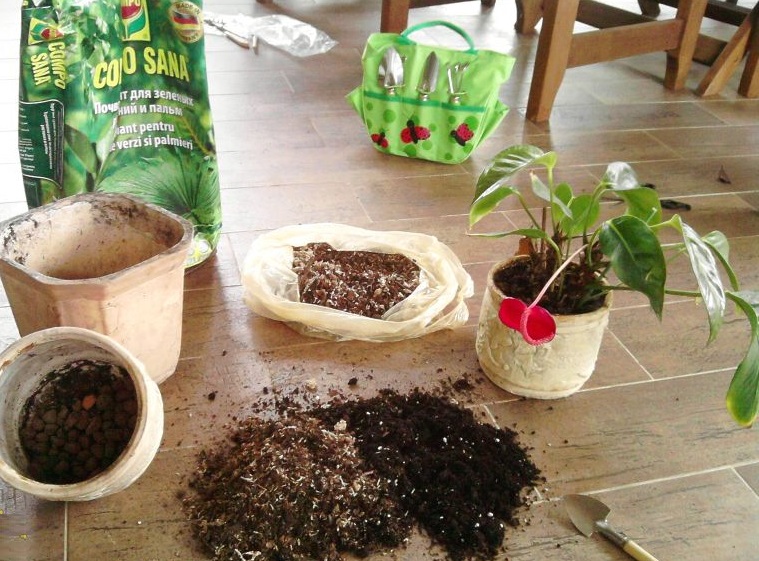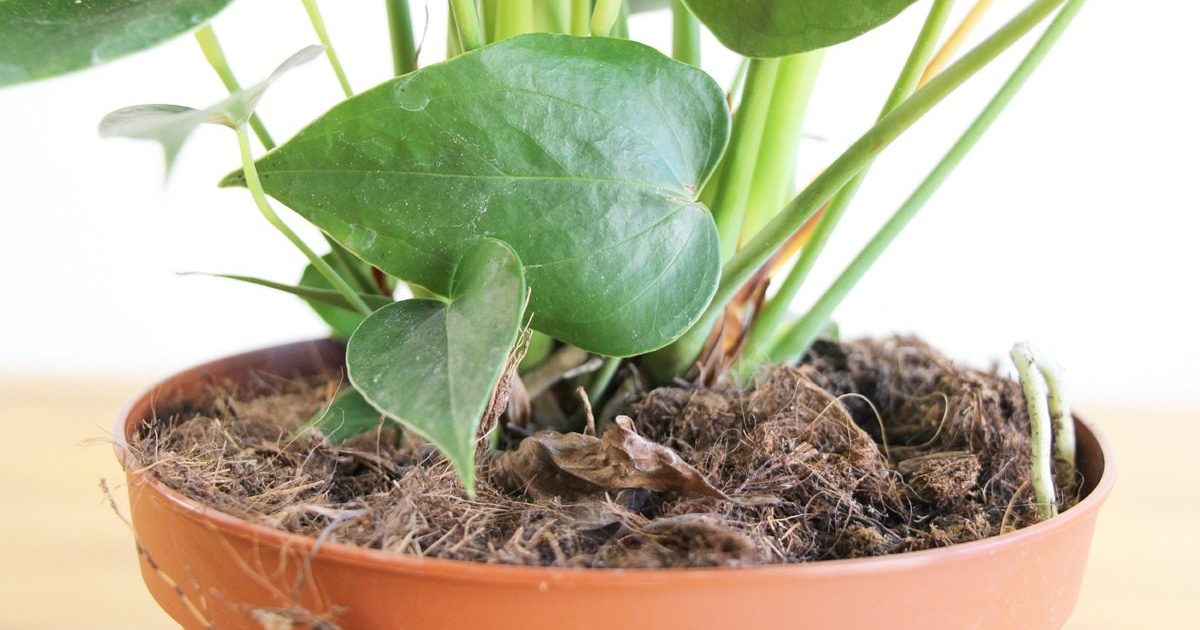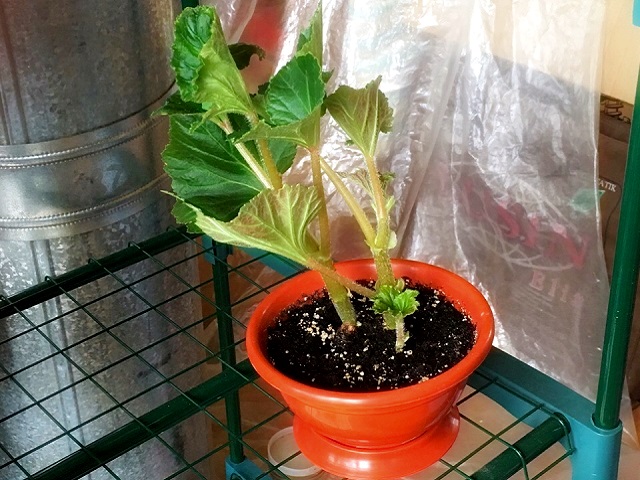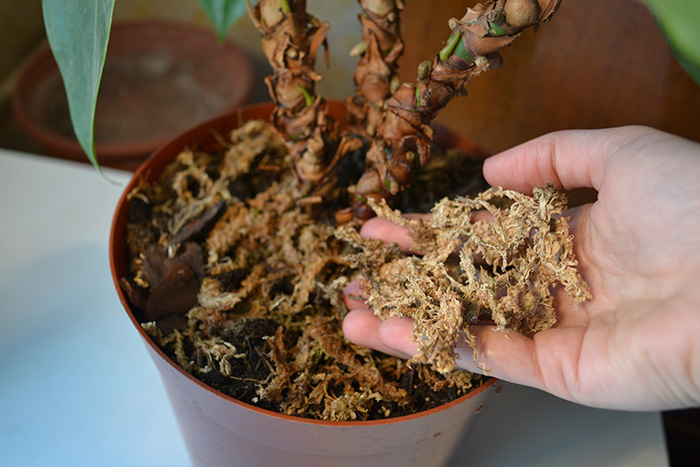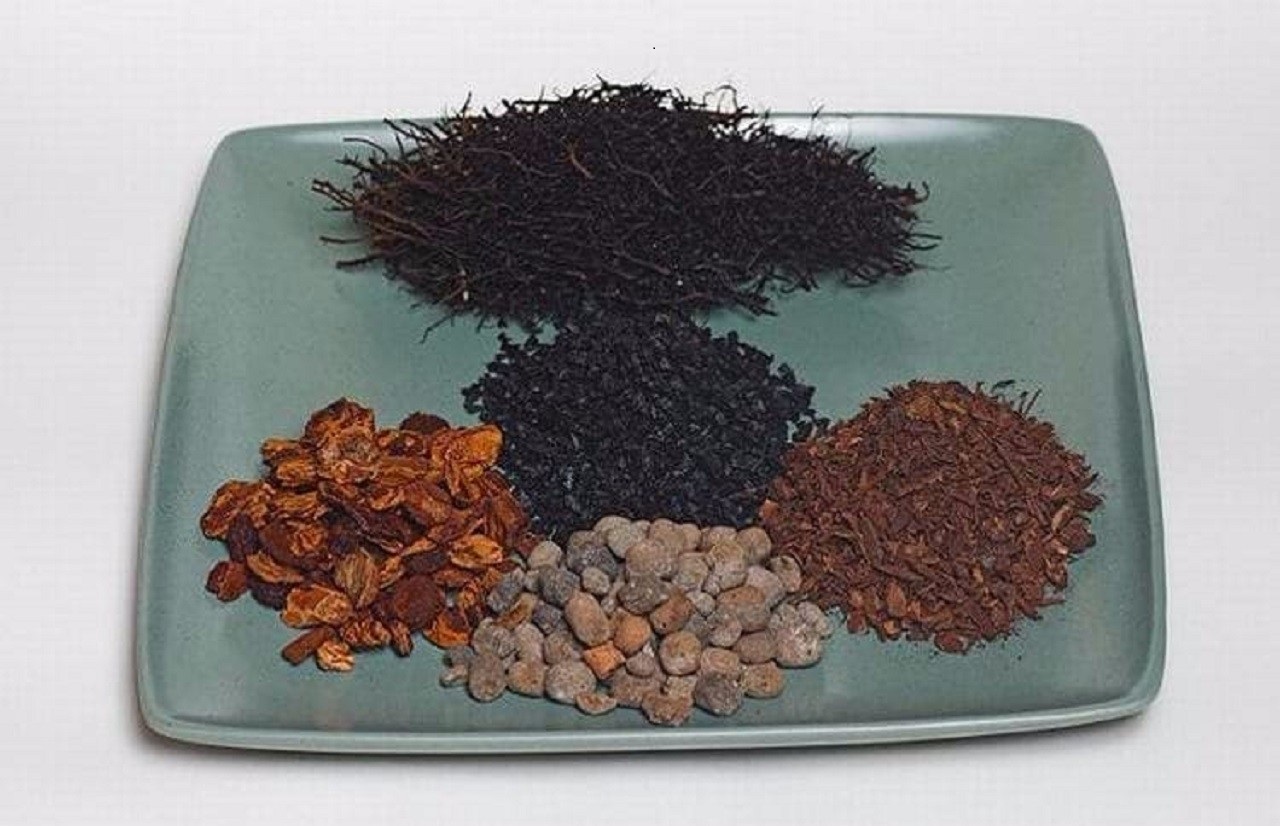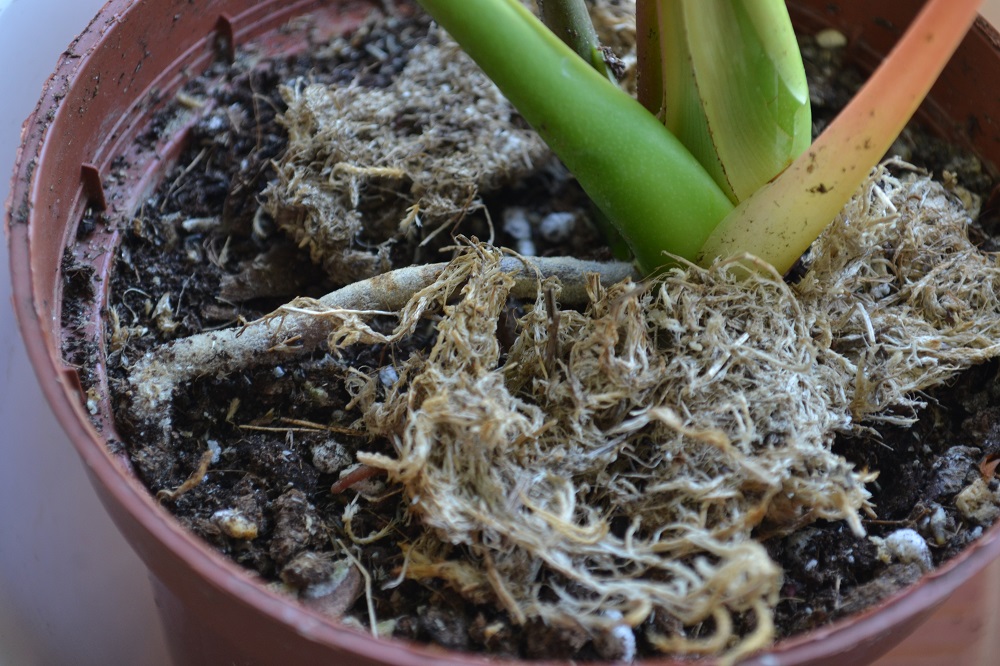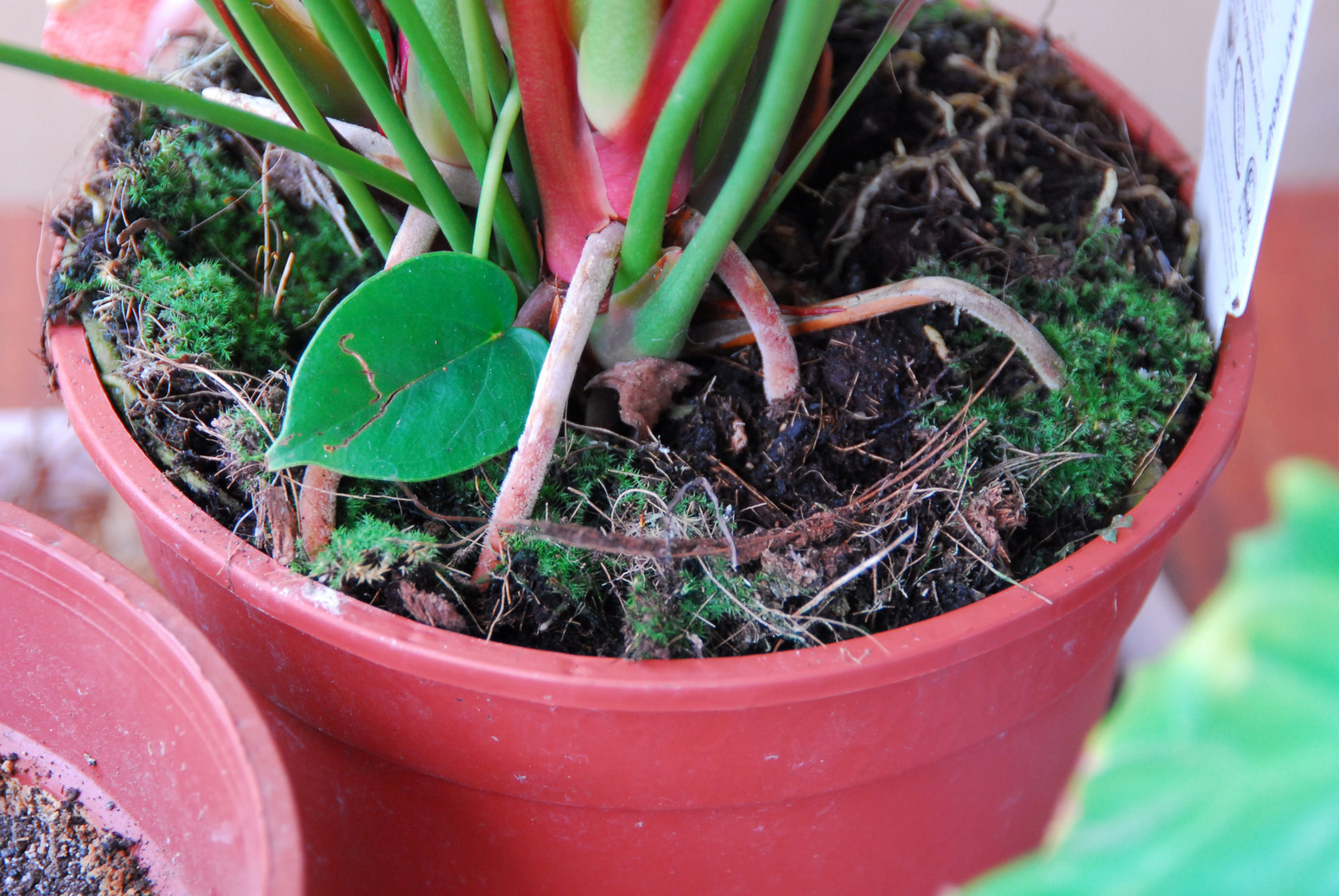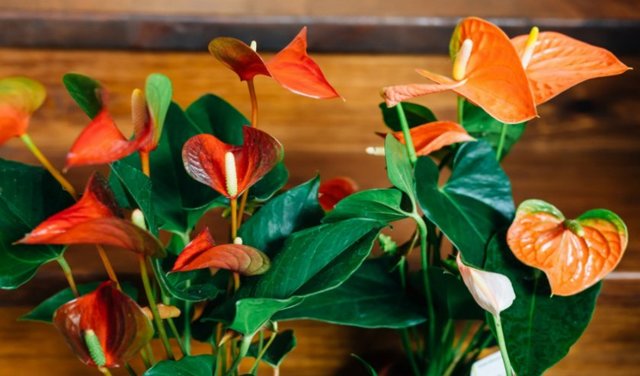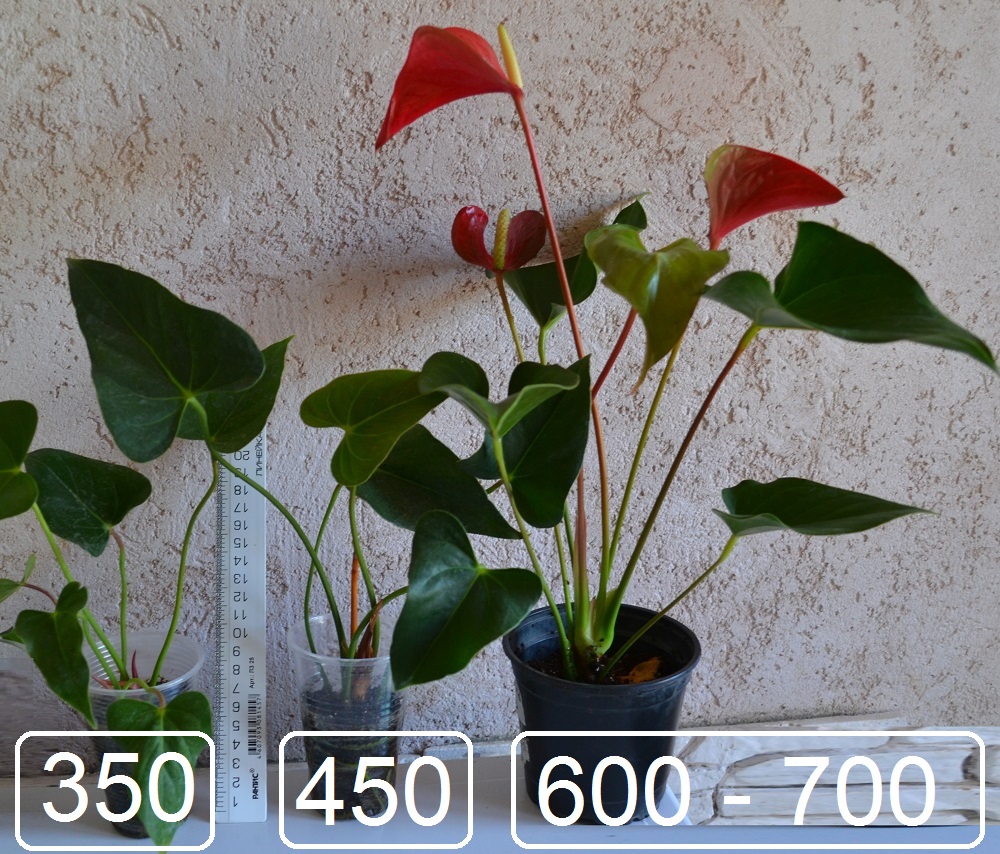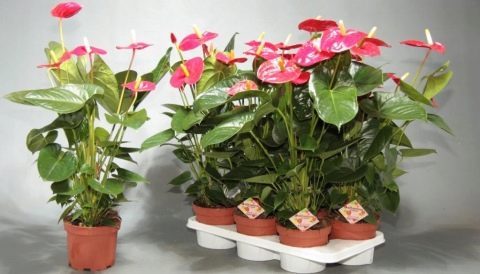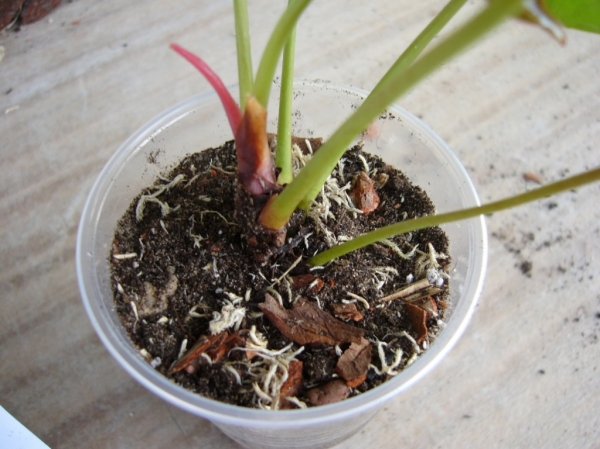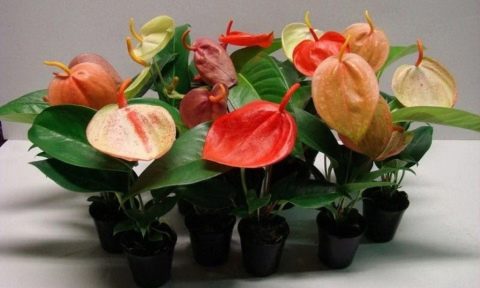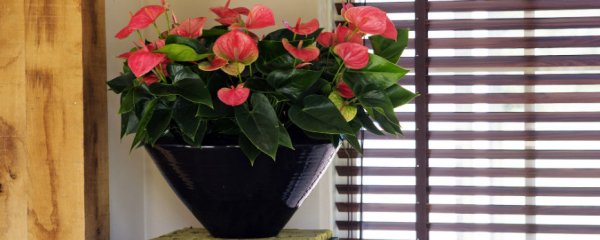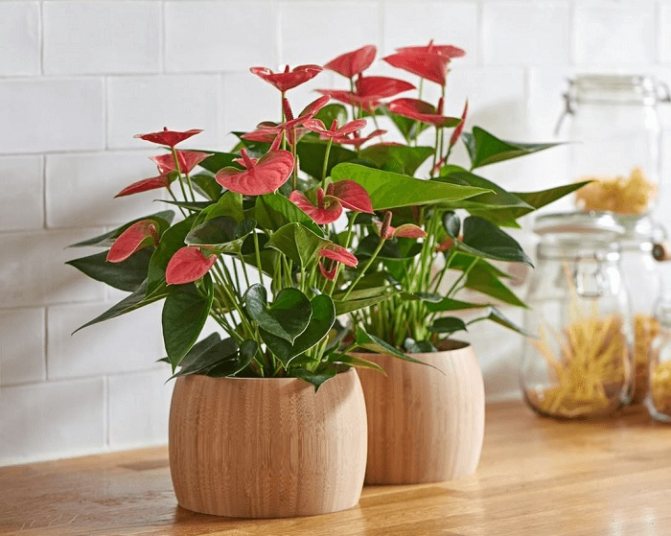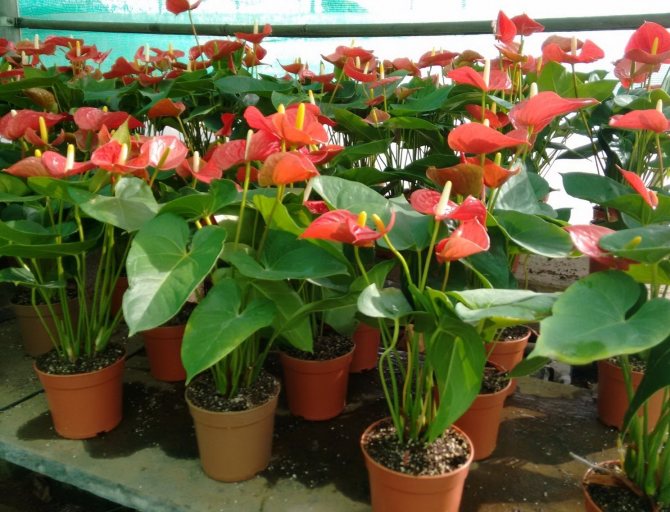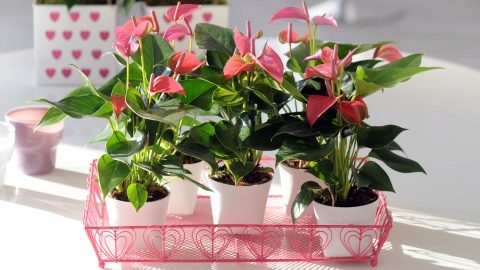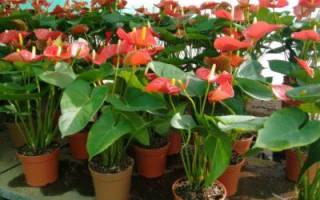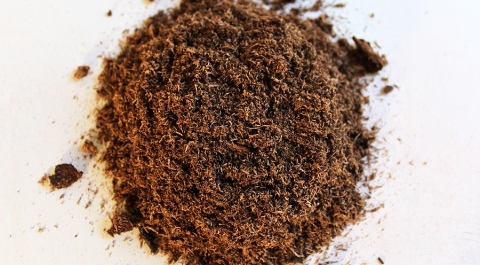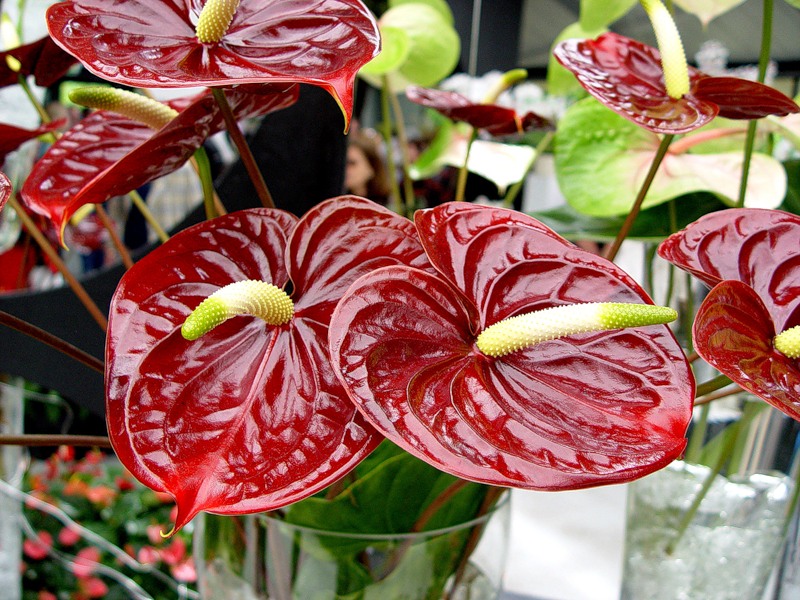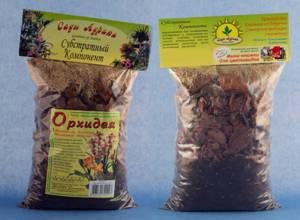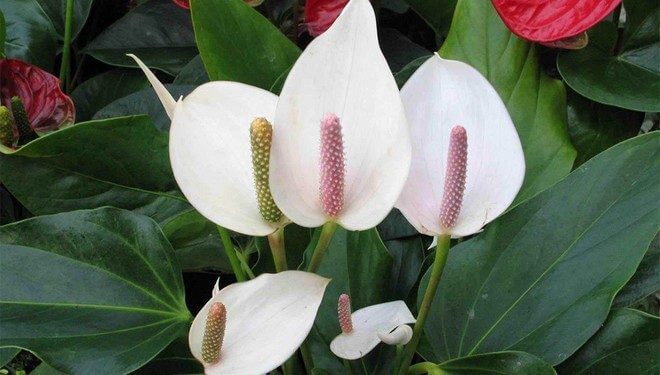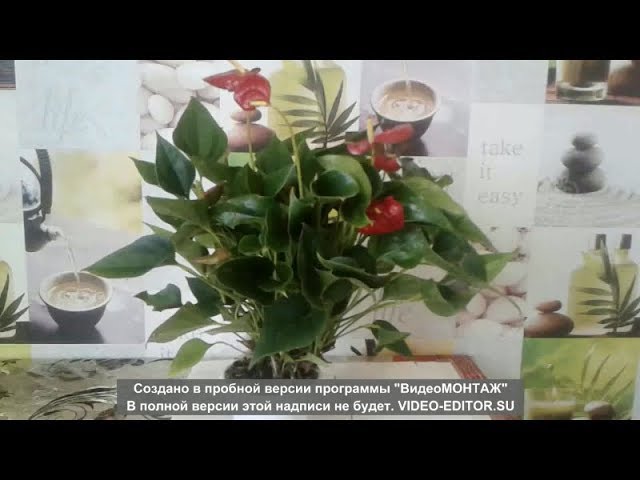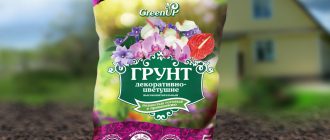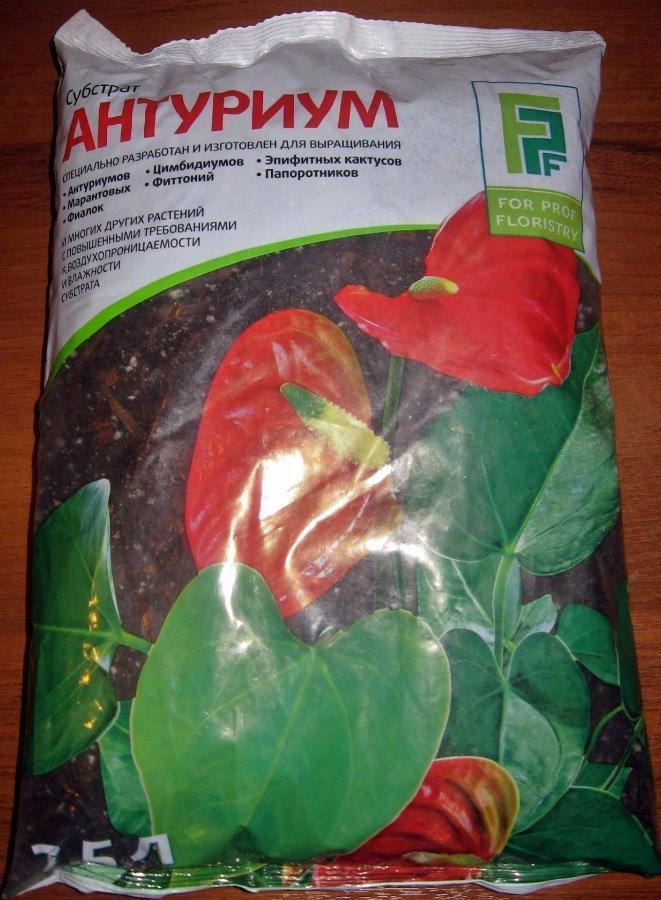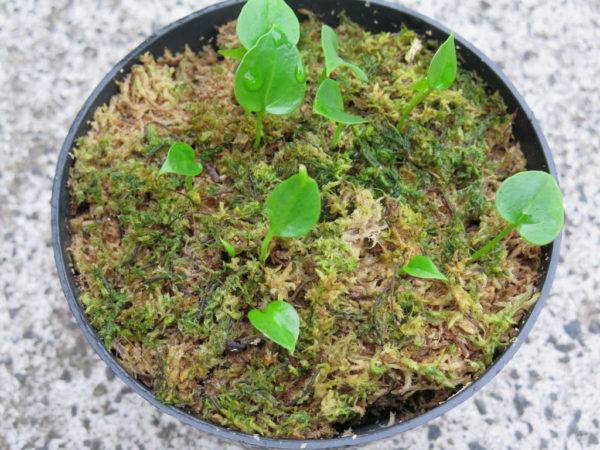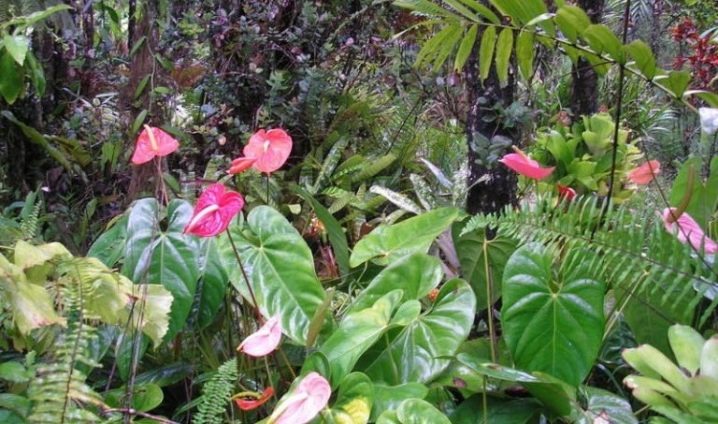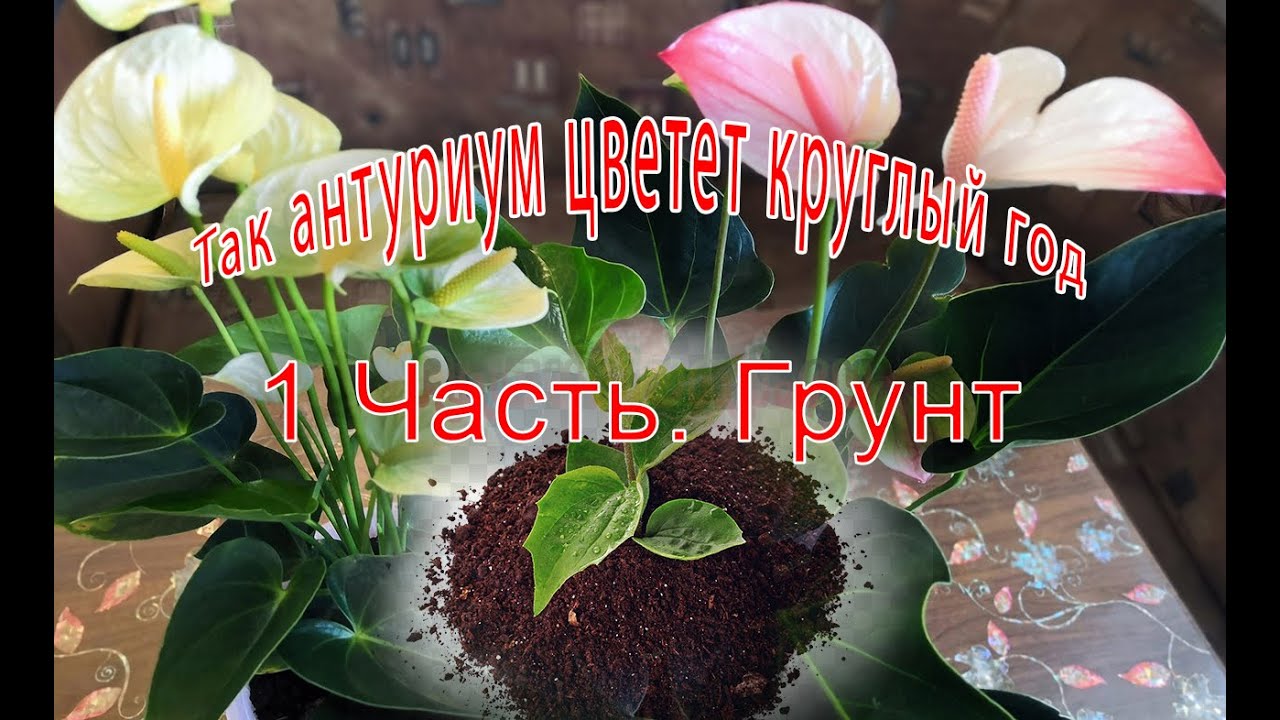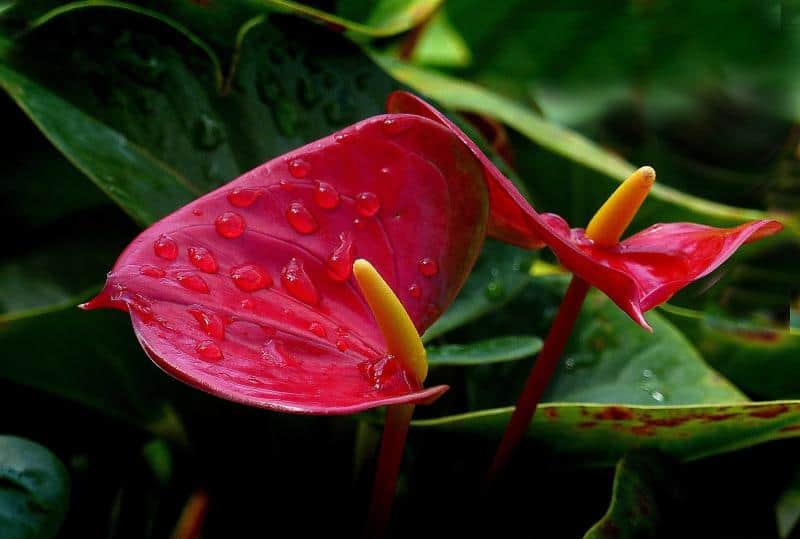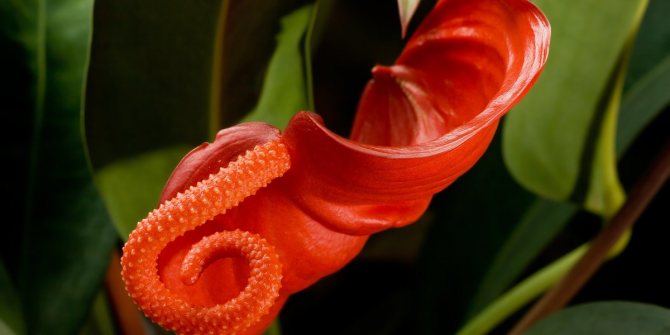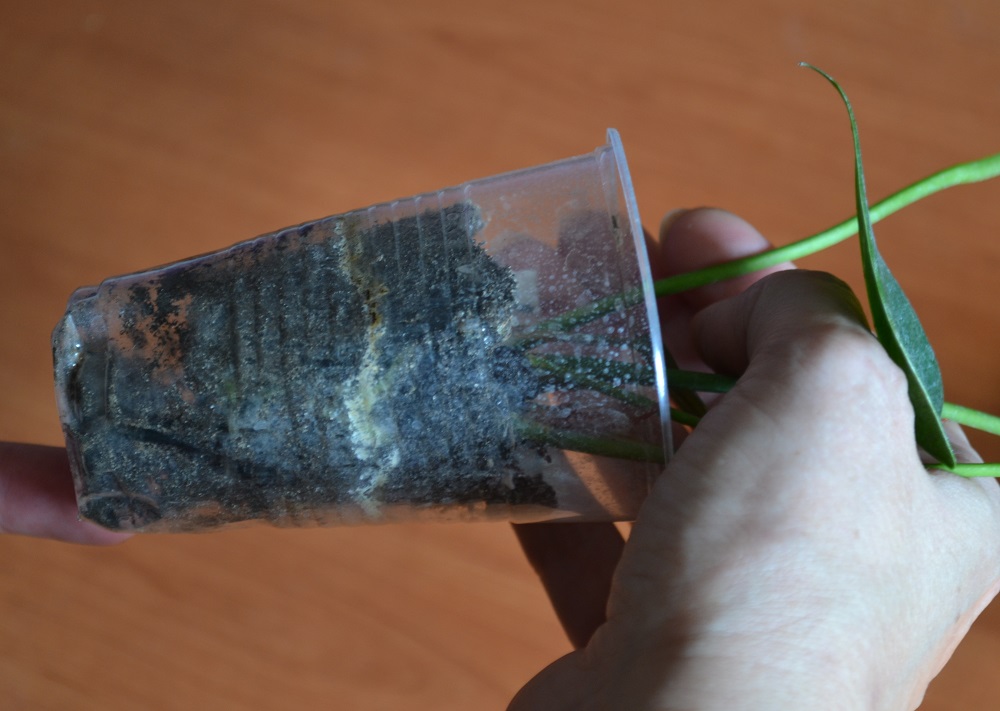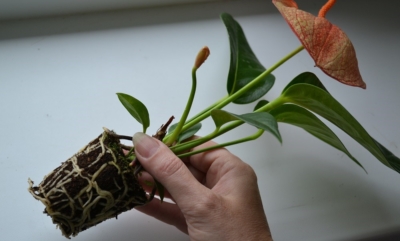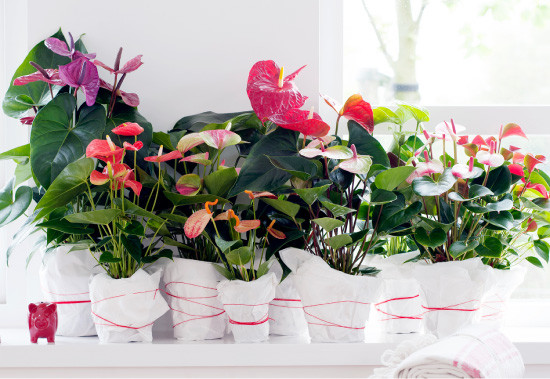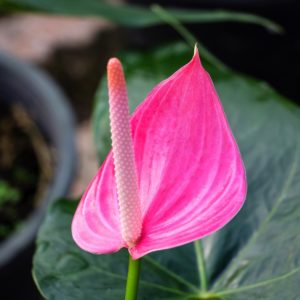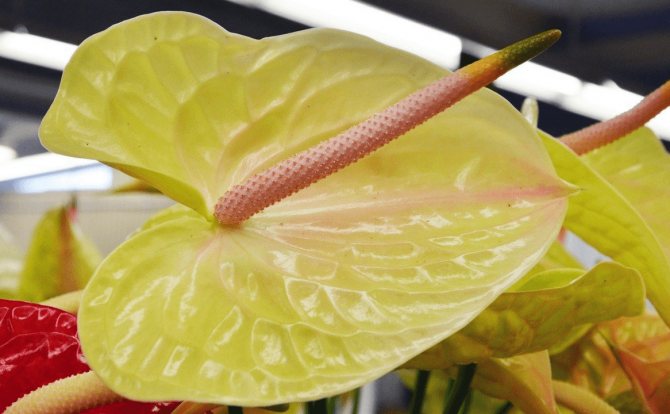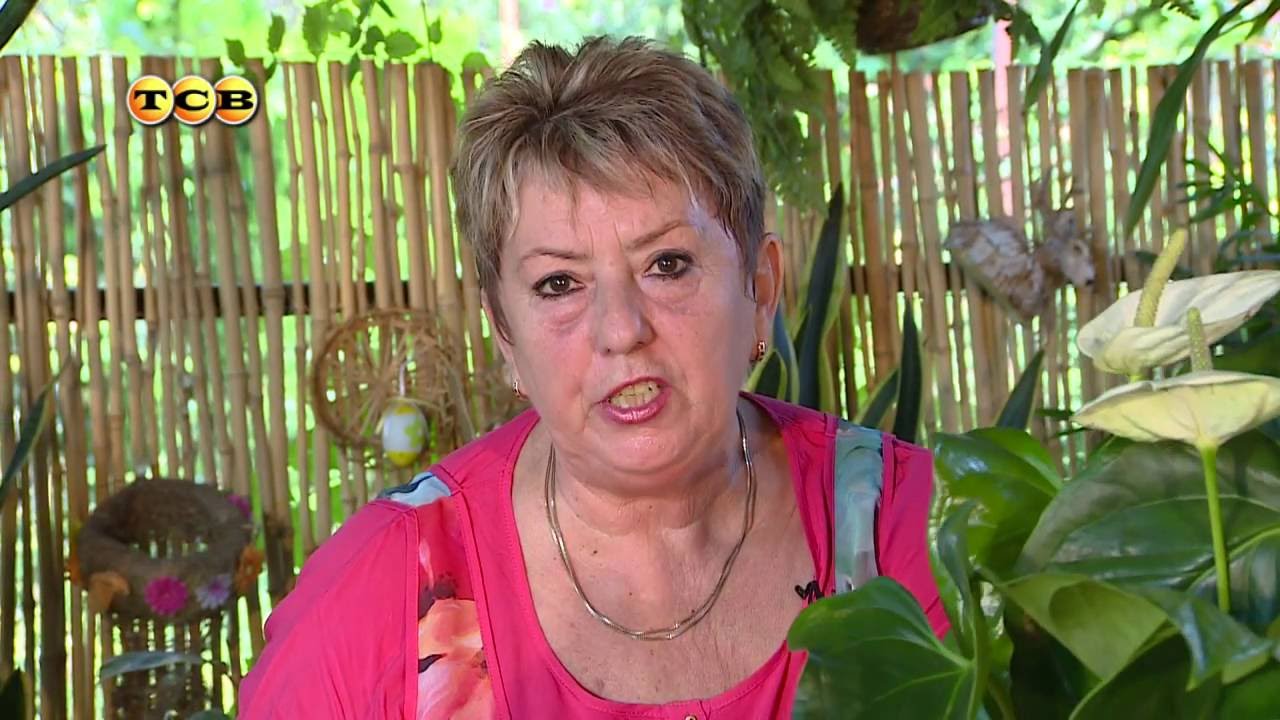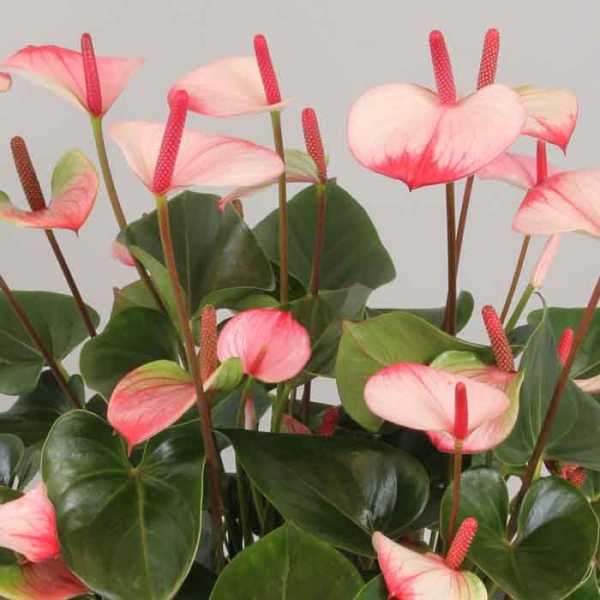What kind of soil care is needed at home?
In the natural environment, representatives of the species are able to grow in various soils, up to clay and sandy loam. But ornamental houseplants are demanding on the composition and consistency of the soil. For indoor plants, it is necessary to ensure good air permeability of the substrate, as well as porosity and drainage. The soil must retain moisture.
Did you know? In the mid-20th century, anthurium became a commercial crop in the Hawaiian Islands. At that time, there were almost 300 farms that specialized in growing the plant. Since then, the demand for these beautiful flowers has not disappeared and they are exported all over the world.

The soil should have the following properties:
- looseness;
- lack of caking;
- the presence of air pockets;
- lack of ability to seal;
- slightly acidic reaction - pH 5.5–6.5.
Anthurium roots are similar to orchid roots, therefore, they have the same soil requirements - sufficient moisture and oxygen access.
The composition of the substrate should include three main components:
- land (turf);
- land (forest);
- sphagnum.
Otherwise, you can improvise by adding other components to the mixture:
- peat;
- land (leaf);
- river sand;
- pine bark;
- small stones;
- expanded clay.
It is also useful to add mineral elements - vermiculite or perlite. In the natural environment, anthuriums grow in forest litter, tree bark, foliage and other forest debris. Therefore, when growing a flower at home, you need to try to imitate the same conditions.
If you do not want to compose the soil yourself, you can try to buy it. Unfortunately, this can be difficult. Few manufacturers produce specialized soil for anthuriums.
- Substrate for anthuriums "Polessky". Contains: high-moor and lowland peat, bark, river sand, coconut fiber and chips, perlite, charcoal.
- A set of substrate components Aroid "Gardens of Aurica". Consists of: sod land, bark and needles, sand, sphagnum.
- Substratum Anthurium "ForPro". Composition: high moor peat, bark, charcoal, agroperlite.
Some soils for orchids with a similar composition (based on peat and bark) are also good for anthuriums. For example, we read the composition of a set of substrate components for orchids from "Auriki's Gardens": peat, bark and pine needles, charcoal, biohumus, sphagnum. Isn't it a soil for anthurium?
The only thing that can be added to such a substrate is a universal soil. To adjust the mixture towards the correct ratio of bark and peat soil (1: 1).
A universal soil for flowers will not work. Due to the lack of air, the roots will begin to rot, which will lead to the death of the plant. The flower needs the maximum imitation of its natural habitat.
Consequences of improperly selected soil:
- Drying out of the plant, despite abundant watering.
- Retarded growth.
- Uneven development of leaves and stem.
- Withering and drying of leaves.
- Lack of flowering.
The following is considered in which soil it is best to transplant a flower from a store, in which soil it will grow well. Self-mixing is the best option. The soil for growing anthurium in is prepared by combining several components. The main thing is to observe the proportions so that the earth turns out to be loose and moderately dense. Otherwise, too light a mixture will not be able to hold the plant, and too dense will suffocate the roots.
What components are used:
- Peat - regulates acidity and enriches the soil with nutrients.
- Sand - lightens the substrate, prevents root rot.
- Charcoal - Provides prevention of fungal infections.
- Turf - makes the mixture porous, which increases breathability.
- Needles - gives looseness to the soil, protects against chlorosis.
- Leafy soil - increases the nutritional value of the substrate.
- Sphagnum moss - regulates water and air exchange.
Peat is sold in garden shops, in packages of 1-2 kg or more. You can also buy sand there, or prepare it yourself. If possible, use river, coarse-grained.
The needles are collected in the forest. The needles need to be rinsed in a bright pink solution of potassium permanganate, then treated with foundation. Sod and leafy soil are best purchased at the store.
Soil recipes:
- Deciduous and coniferous soil, peat, sand in a ratio of 1: 1: 1: 0.5.
- Sod, sand, deciduous humus in a ratio of 1: 1: 2.
- Sod, sand, sphagnum, peat - 2: 1: 1: 4.
- Coniferous bark, moss, peat, turf - 1: 1: 1: 2.
After planting the flower, a layer of sphagnum is placed on top of the prepared soil. It retains moisture and protects the roots from drying out.
Step 6: planting anthurium
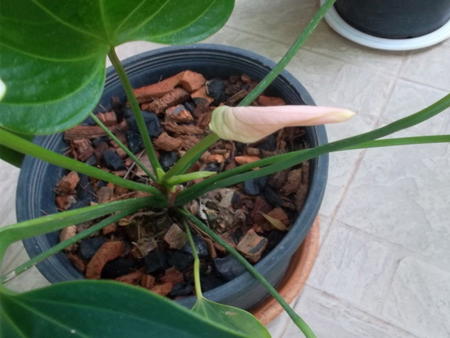
The main thing is to provide the plant with a high-quality earthen mixture and drainage. Some growers leave anthurium in the store soil. Nevertheless, such a peat-coke substrate has quite significant disadvantages.
The substrate has a high moisture capacity. This means that after watering, the soil inside will remain moist for a long time, and on top it will dry out quickly. In addition, the soil does not allow air to pass through well, which is necessary for the normal development of the root system.
Preparing drainage
Various components can be used as drainage.
1. Expanded clay. Before using it, it is better to rinse it and even boil it, thus, silicate salts harmful to anthurium are removed from it.
2. Broken shards. Can be made from pottery. The main thing is that shards with sharp edges do not fall into the pot with the plant, this can harm the anthurium.
3. Stones. For the preparation of drainage, stones are used no more than one and a half centimeters in diameter and at least half a centimeter. The necessary small stones are sold at aquarium stores.
4. Styrofoam. Easy to cook on your own, just break it into pieces of the required size.
Substrate for anthurium
The best substrates for anthurium are loose-textured substrates, consisting of coarse fibers, as well as moisture and air permeable. An acidic soil is also required.
Basic soil requirements:
- Should provide support to the plant;
- Dries easily;
- Should not decompose and thicken.
If you are preparing the substrate yourself, use the following composition: two parts of peat, two parts of sphagnum moss and one part of soil. You can also add sand to the earthen mixture, charcoal and shredded bark coniferous trees.
Another variant of the composition of the soil is possible: two parts of deciduous land, one part of sphagnum moss and sod land. You can add a little bone meal to this mixture.
An earthen mixture of the following composition is suitable: large expanded clay, peat and bark of pine trees. All components are present in equal proportions.
As for the choice of ready-made earthen mixture, this can be done in any specialized store.
It is important that there are no white balls in it that easily crumble between the fingers.
The substrate can be changed from time to time and thus choose the most suitable one for your anthurium.
What composition of the substrate is best suited to plant a flower: instructions for preparation
The following is considered in which soil it is best to transplant a flower from a store, in which soil it will grow well. Self-mixing is the best option. The soil for growing anthurium in is prepared by combining several components. The main thing is to observe the proportions so that the earth turns out to be loose and moderately dense. Otherwise, too light a mixture will not be able to hold the plant, and too dense will suffocate the roots.
What components are used:
- Peat - regulates acidity and enriches the soil with nutrients.
- Sand - lightens the substrate, prevents root rot.
- Charcoal - Provides prevention of fungal infections.
- Turf - makes the mixture porous, which increases breathability.
- Needles - gives looseness to the soil, protects against chlorosis.
- Leafy soil - increases the nutritional value of the substrate.
- Sphagnum moss - regulates water and air exchange.
Peat is sold in garden shops, in packages of 1-2 kg or more. You can also buy sand there, or prepare it yourself. If possible, use river, coarse-grained.
The needles are collected in the forest. The needles need to be rinsed in a bright pink solution of potassium permanganate, then treated with foundation. Sod and leafy soil are best purchased at the store.
It is possible to prepare leaf humus on your own, but this will take 1.5-3 years. Foliage is collected from under fruit trees, folded in bags and left on the site until complete rotting.
We suggest watching a video on how to prepare soil for anthurium at home:
Soil recipes:
- Deciduous and coniferous soil, peat, sand in a ratio of 1: 1: 1: 0.5.
- Sod, sand, deciduous humus in a ratio of 1: 1: 2.
- Sod, sand, sphagnum, peat - 2: 1: 1: 4.
- Coniferous bark, moss, peat, turf - 1: 1: 1: 2.
After planting the flower, a layer of sphagnum is placed on top of the prepared soil. It retains moisture and protects the roots from drying out.
Indoor plant description
Anthurium belongs to herbaceous perennial plants of the aroid family. This delicate tropical flower has another name - flamingo. The leaves of the plant are dense, covered with a matte film, up to 20 cm long. The inflorescence is an ear, around which there is a colored veil-bracts. It is rolled up in a tube so that the ear is clearly visible. Natural varieties have crimson bracts. Modern varieties and hybrids have a variety of colors, from blue to red, there are varieties with a speckled bedspread. The flowers are fragrant.
After the flower has faded, the perianth turns green and becomes a leaf. Flowers are small, complex pollination system. In their place, round-shaped fruits are formed. Seeds ripen up to one and a half to two months. They must be sown immediately after collection. Reproduction of anthurium can be carried out by seeds after artificial pollination or vegetatively, by dividing a bush or cuttings. The second way is much easier and more productive. Anthurium has about 100 flowering hybrids. If propagated by seed, the properties of the parent variety are often not transmitted.
Despite the fact that there are about 500 species and varieties of this plant, the following are grown in room conditions:
- Anthurium Andre with red flowers of all shades or white. Andre Dakota is the most popular variety.
- Anthurium scherzerianum (Scherzer) up to 25 cm high and up to 40 cm wide. The leaves are arrow-shaped, the flowers are red, less often white or spotted. After the beginning of flowering, they appear continuously and bloom several pieces at a time. Flowering continues even in winter, but in summer the number of flowers is greater.
- Anthurium andreanum requires a higher temperature to grow and is therefore not common in apartments. The flowers are very large, cut for several weeks.
- Anthurium crystallinum is also demanding in terms of temperature and humidity. It is prized for its beautiful velvety leaves with silvery veins. The shape of the leaves is heart-shaped.
Ground requirements for spathiphyllum
Before choosing a soil for a plant, you need to find out in what conditions it grows in nature. The homeland of spathiphyllum is the humid subtropics. It grows mainly along rivers, lakes or in wetlands. In such places, the soil is usually rich in humus and peat.
What should be the soil for spathiphyllum:
- loose;
- breathable;
- moisture permeable;
- easy;
- fertile;
- slightly acidic.
The acidity of the soil should be within 5.5. If the level of acidity is elevated, then dolomite flour, slaked lime or wood ash can be used to reduce it.
Note! To increase air permeability, river sand is added to the substrate. Good drainage is also required - pebbles or expanded clay
What is the composition of the soil is necessary for a flower female happiness
Before buying soil, you need to study the composition well. But before that you need to figure out which ingredients must be included in the soil mixture, and which should not be there. For successful cultivation, you need to know in advance what kind of soil does he like spathiphyllum.
What kind of land is suitable for spathiphyllum and what should be included in:
- sand, agroperlite or vermiculite;
- deciduous or sod land;
- peat;
- humus;
- superphosphate;
- charcoal.
The base is deciduous or sod land. It should be most of all in the composition. Peat and humus are added in the same amount. Ingredients such as sand, agroperlite and charcoal should take up no more than 10% of the total mass of the substrate.
Advice! You can use ground brick, small pieces of bark as a baking powder.
Should the land for planting and replanting be different
The soil for spathiphyllum, as well as for the closest relative of this Anthurium flower, during planting and transplantation, may be the same in composition. It is not necessary to change the composition of the soil with each transplant. You can even leave the drainage layer old, just rinse it thoroughly before replanting the flower.
In the summer, you can transplant the flower outdoors in open ground. It is planted along with the substrate in which it grew in a pot at home.
How to determine if the soil needs to be changed?
Alarms are easily identified by their appearance:
- Root outgrowths sprout through the drainage holes at the bottom of the pot.
- Pests (mites, aphids, cobwebs) were found on the surface of the topsoil and on the plant itself.
- When leaves, roots, stems are infected with rot, fungus, spot infections, they partially or completely change the soil.
- The flower itself is cut, transplanted, quarantined.
Disinfection of soil
When transplanting a flower, it is very important to carry out preventive soil treatment, because plants planted in self-prepared mixtures are threatened not only by fungi and bacteria, but also by the presence of pest eggs. There are several ways to disinfect the substrate:
There are several ways to disinfect the substrate:
- "Frosty treatment". In winter, the substrate is taken out into frosty air and left for 4-5 days. In this case, the air temperature should not be higher than - 5 - 7 ° С. During such a period of time, pathogens existing in the soil will die.
- Heat treatment. The soil is disinfected under the influence of high temperature. The processing rules are as follows, the soil is kept in an oven preheated to 80 ° C for an hour to provide reliable protection against the development of harmful microorganisms.
- Steam treatment. Another reliable way to neutralize soil is to steam it. To do this, wrap the soil in a cloth and place it on a wire rack above the steam bath. This procedure must be carried out for at least an hour and a half.
- Treatment with a disinfectant mixture. For such treatment, you can use fungicides, or you can prepare a disinfectant solution yourself. To prepare it, dissolve 3 grams of potassium permanganate (potassium permanganate) in 5 liters of boiling water and process the ground. It is recommended to use industrial biological mixtures - "Agate" or "Integral". They include beneficial bacteria that kill pathogens. The method of their use is indicated on the packaging.
It is important to know that such substrate components as peat and moss create favorable conditions for healthy soil flora and should not be processed.It is necessary to mix all parts of the soil after the processed components have cooled.
What kind of drainage is needed for growing?
The health and beauty of anthurium depends on the availability of drainage, because these plants do not tolerate stagnant water in the root system and can die. To create optimal conditions for flower growth, you need to think about good drainage, only in this case excess water will go away and the roots will breathe.
The following materials are suitable for preparing drainage:
- clay shards;
- broken brick;
- expanded clay;
- gravel;
- crushed stone;
- Styrofoam.
The most popular material for drainage is expanded clay, it is able to absorb excess moisture. These are burnt pieces of clay that have a porous structure. You can buy it in flower shops.
When using other materials as drainage, the following tips should be followed:
Does anthurium need drainage
Often, flower growers have a question: "Do anthuriums planted in a mixture of bark and peat need drainage?" The answer is unequivocal, drainage is vital, because stagnant water in a flowerpot is destructive for them. Drainage can be made from expanded clay, brick, large fragments of bark, and even from foam. The drainage pockets should be large enough, so use large pieces of your chosen material. Be sure to disinfect the material for the manufacture of drainage, having previously scalded it several times with boiling water.
Often there is no need to transplant anthurium, but a serious approach to this issue is required. If you follow all the recommendations and choose the right soil, then the tropical guest will thank you not only with lush color, but also cleanse home air from such harmful impurities like xylene, ammonia and formaldehyde.


